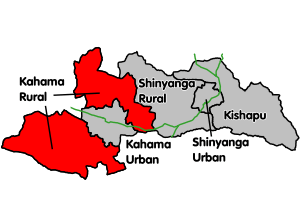Kahama Rural District
Kahama Rural District is one of the five districts of the Shinyanga Region of Tanzania. Its administrative centre is the town of Kahama. The district consists of two separate parts, divided by Kahama Urban District. The area to the northeast is Msalala Council, while the part to the southwest is Ushetu Council.[1]
Kahama Rural District | |
|---|---|
 Kahama Rural's location within Shinyanga Region. Trunk roads in green. | |
| Coordinates: 03°50′S 032°35′E | |
| Country | Tanzania |
| Region | Shinyanga Region |
| Population (2012) | |
| • Total | 523,802 |
According to the 2012 Tanzania National Census, the population of the Kahama Rural District was 523,802.[2]
Transport
Paved Trunk road T3 from Morogoro to the Rwanda border passes through Kahama Rural District from east to west.[3]
There is a train station and a dry port at the town of Isaka, on the stretch of Mwanza railway line going from Tabora to Shinyanga.[4]
Wards
As of 2012, Kahama Rural District was administratively divided into 35 wards.[2]
|
|
|
|
|
References
- "Karibu Mkoani Shinyanga". Shinyanga Region. Retrieved 13 April 2016.
- "Census 2012". National Bureau of Statistics. Archived from the original on 2016-03-05.
- "Trunk and Regional Roads in Tanzania". Tanroads. Archived from the original on 8 December 2015. Retrieved 1 December 2015.
- "Tanzania Railways Corporation". Tanzania Railways Corporation. Retrieved 7 December 2015.